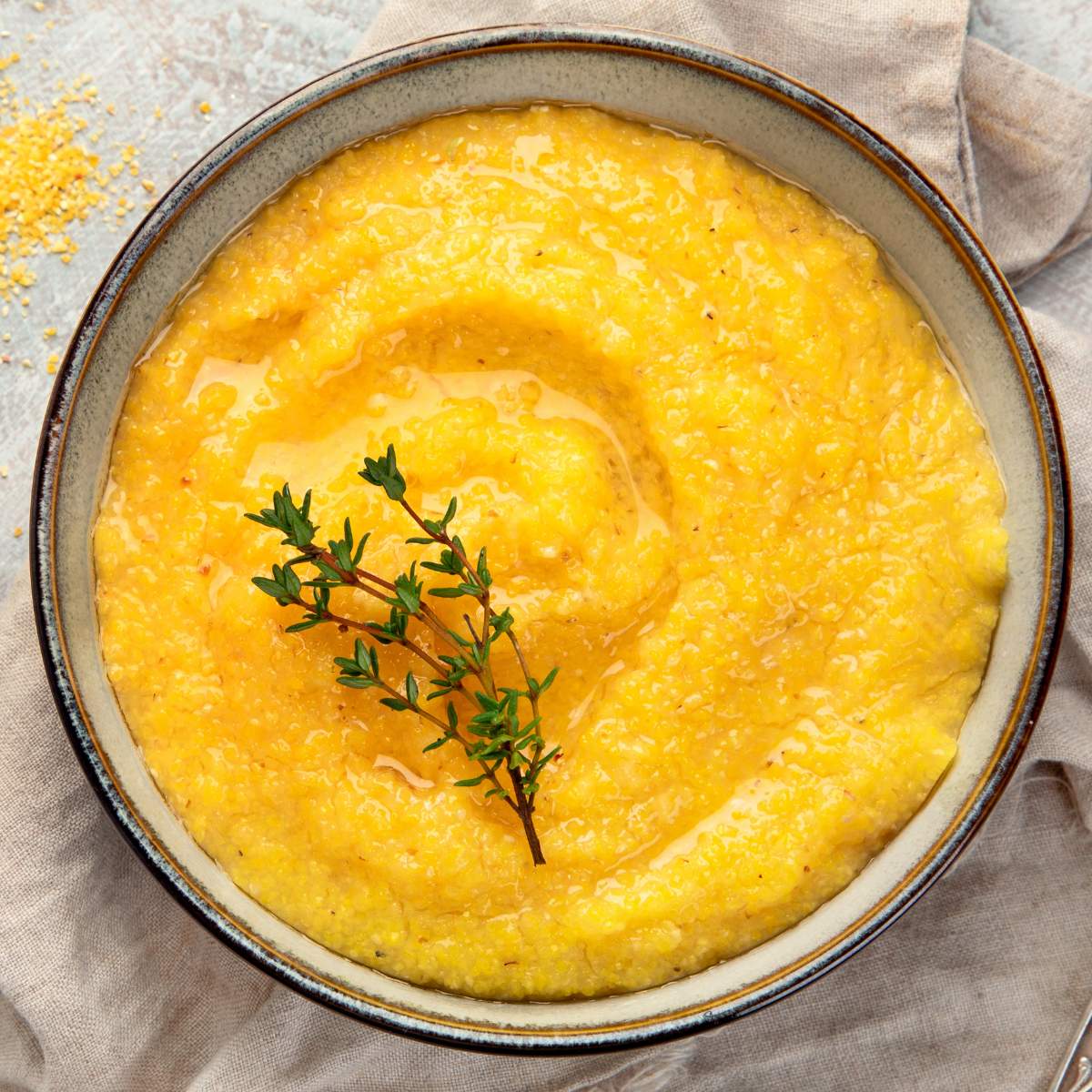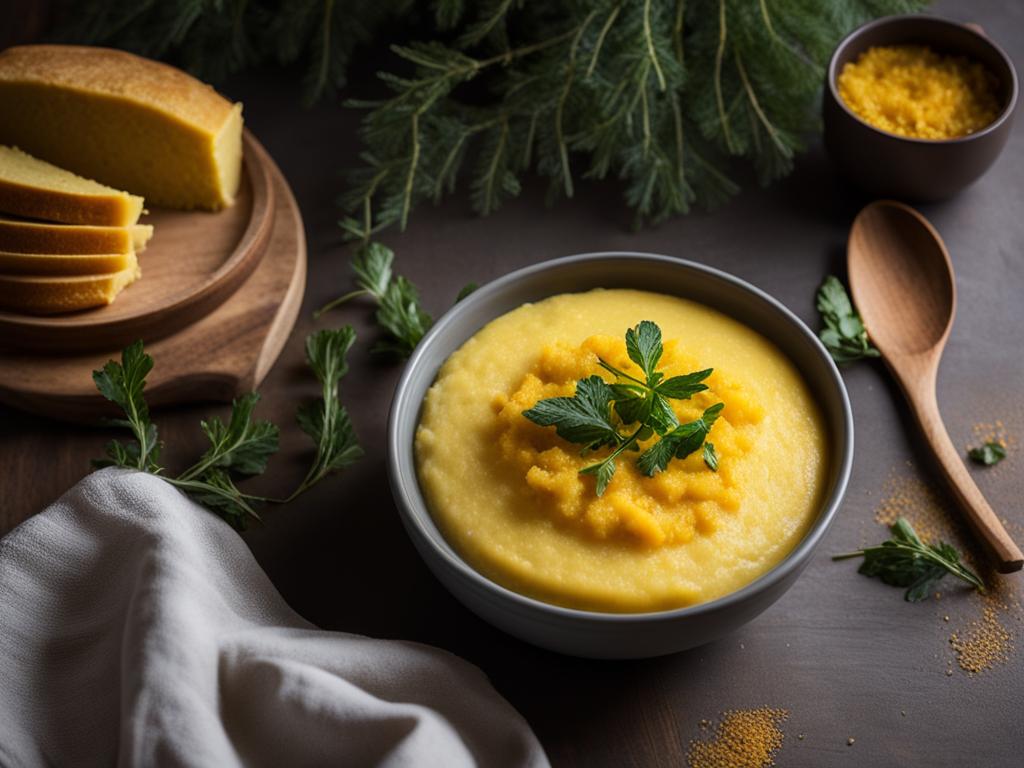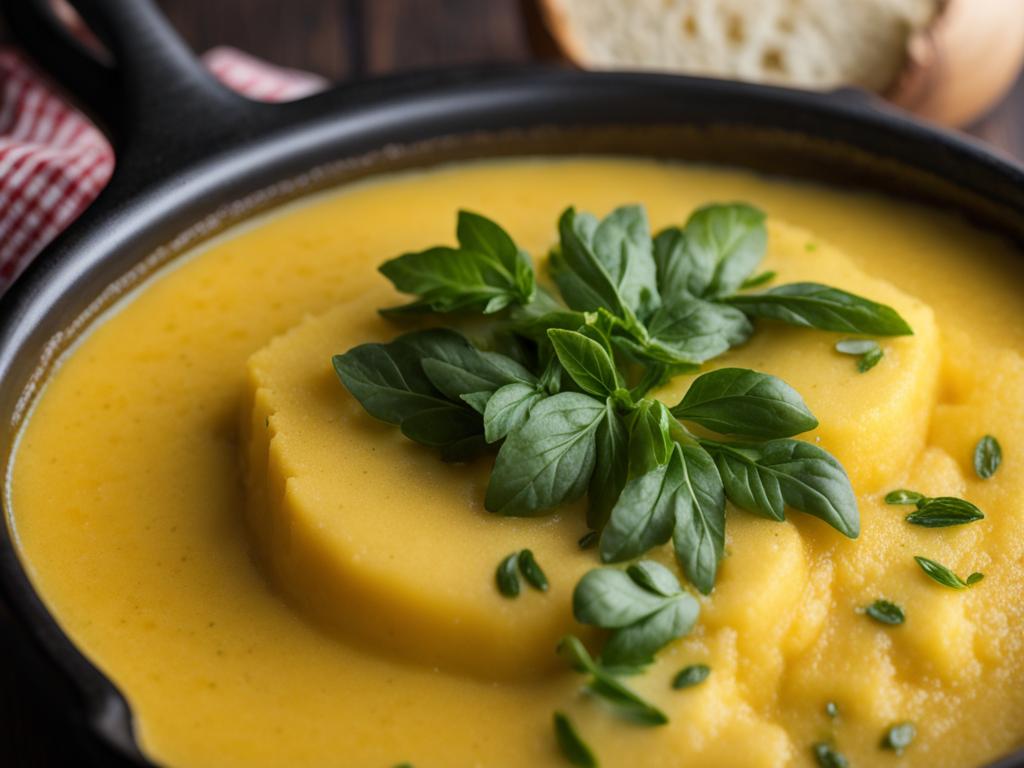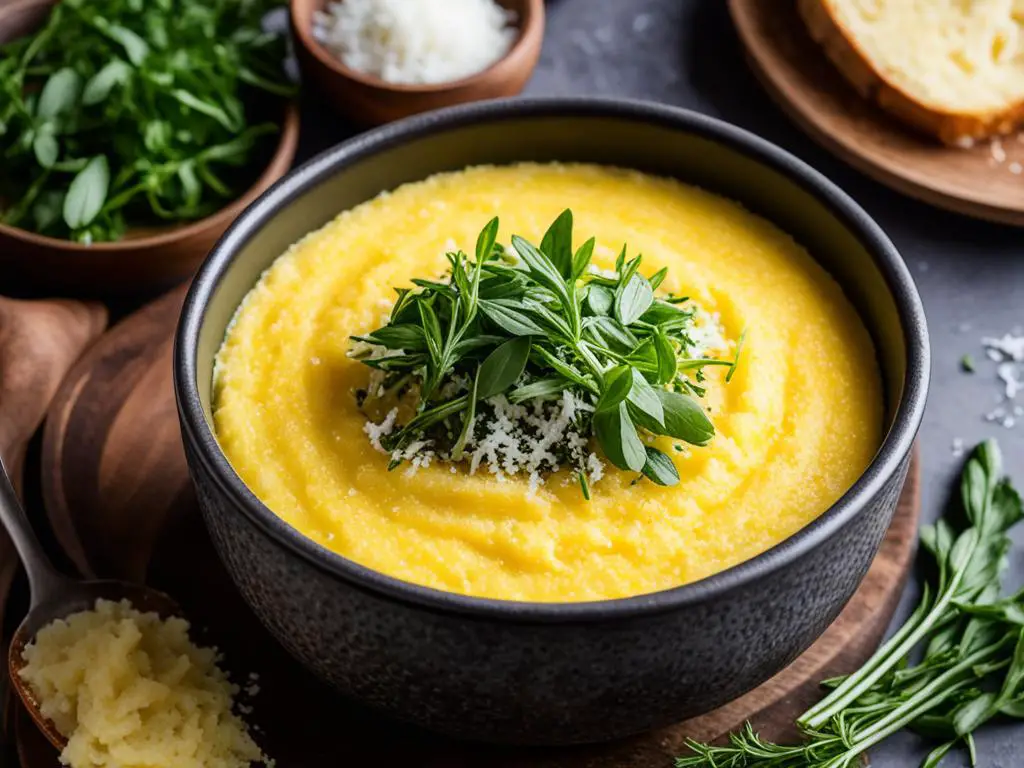Welcome to the delectable world of polenta! This beloved Northern Italian dish has won hearts and taste buds around the globe with its simplicity and versatility. Made from coarsely ground yellow corn, polenta is a staple in both home kitchens and renowned restaurants.
Its humble ingredients, including cornmeal, butter, salt, and pepper, create a comforting and satisfying dish that can be enjoyed in various ways.
Polenta offers endless possibilities when it comes to culinary creativity. Whether you’re frying it up with marinara sauce, serving it as a creamy companion to meat dishes, or using it as croutons on salads, polenta effortlessly adapts to different flavors and preparations.
The silky texture and subtle corn flavor of polenta serve as a perfect canvas for other ingredients, allowing you to experiment and bring your own twist to this classic dish.
In this article, we’ll dive into the details of what makes polenta so special. From understanding polenta main ingredients and how polenta is cooked, to exploring mouthwatering polenta recipes for every meal, you’ll discover the true magic of polenta and why it has become a cherished part of Italian cuisine.
Key Takeaways:
- Polenta is a popular Northern Italian dish made from coarsely ground yellow cornmeal.
- It is known for its simplicity and versatility, making it a favorite in both home kitchens and restaurants.
- Polenta can be served in various ways, such as fried with marinara sauce, as a creamy accompaniment to meat dishes, or as croutons on salads.
- It is made by slowly cooking the cornmeal with water or stock, butter, salt, and pepper until it reaches a smooth and creamy consistency.
- Polenta can be enhanced with additional flavors like parmesan cheese or used as a base for savory dishes like lasagna and as a gluten-free alternative in cakes.
What is Polenta Made of?
Polenta is a delightful dish made from stone-ground dried yellow corn kernels, resulting in a textured and flavorful base. The key ingredient in polenta is a specific variety of corn known as flint corn, which contains less starch compared to the dent corn used for making grits. This distinction in starch content contributes to the unique taste and texture of polenta.

Unlike finely ground cornmeal often used as a substitute, polenta retains a flaky consistency that adds depth to dishes. When shopping for polenta, it’s essential to choose packages specifically labeled as such to ensure the authentic flavor and texture.
While instant, quick-cooking, or tubed polenta may seem convenient, they often lack the robust flavor and can have a mushy consistency.
“Polenta is a textured and flavorful base made from stone-ground dried yellow corn kernels.”
When cooked, polenta becomes a versatile canvas for various culinary creations. Its distinct taste and textured characteristic make it a beloved ingredient in both traditional Italian cuisine and modern interpretations.
Whether it’s served alongside hearty meats, transformed into crispy fries, or used as a base for lasagna or cakes, polenta offers a unique and satisfying dining experience.
To visualize the process of making polenta, take a look at this table:
How to Cook Polenta
Cooking polenta is a simple and rewarding process that results in a creamy and flavorful dish. The key to making perfect polenta lies in frequent stirring and using the right tools. While a traditional copper polenta pot is ideal for achieving the best results, a medium-sized saucepan will also do the job just fine.
Tips for Success:
- Use a whisk or wooden spoon for stirring to ensure the polenta cooks evenly and doesn’t stick to the bottom of the pot.
- Be patient and stir frequently to achieve that smooth and creamy texture.
- If the polenta becomes too thick, you can add more liquid, such as water or stock, as needed.
Once your polenta is cooked to perfection, it’s ready to be served as a side dish or as a base for other delicious creations. Feel free to get creative with toppings and flavor additions to make it truly your own!
Polenta Through History
Polenta, a traditional dish with a rich history, can be traced back to ancient Roman times. In those days, it was known as puls, a porridge made from various grains. Fast forward to medieval times, when polenta was made from chestnut flour, which was abundant in northern Italy.
However, it wasn’t until the introduction of corn from the Americas in the 16th century that cornmeal became the primary ingredient in polenta, elevating it to the status of a beloved traditional dish.
Polenta has played a significant role in Italian cuisine, especially in the northern regions, where it has been a staple for centuries. Its popularity is not limited to Italy, though. Polenta has gained recognition worldwide for its versatility and delicious flavor.
“Polenta: an ancient Roman dish that has stood the test of time, evolving into the hearty and comforting dish we know today!”
From its humble beginnings as a porridge made from different grains in ancient times, to its transformation with the introduction of cornmeal, polenta has a fascinating journey through history. It has become a traditional dish that embodies the flavors and traditions of northern Italy, capturing the hearts and palates of people around the world.
Evolution of Polenta
Over time, polenta has evolved from a humble porridge into a versatile dish that can be prepared in various ways. Let’s take a look at the different stages of polenta’s evolution:
| Time Period | Key Ingredient | Characteristics |
|---|---|---|
| Ancient Roman times | Various grains | Simple porridge known as puls |
| Medieval times | Chestnut flour | Commonly consumed in northern Italy |
| 16th century | Cornmeal | Introduction of corn from the Americas |
| Present day | Cornmeal | A beloved traditional dish, enjoyed worldwide |
Polenta’s evolution reflects the changing culinary landscape throughout history, as well as the adaptability and creativity of people in incorporating new ingredients and flavors into their traditional dishes.
Today, polenta remains a cherished part of Italian cuisine and continues to be celebrated for its versatility and delicious taste. From creamy polenta served alongside braised meats to crispy polenta fries, it’s clear that polenta has come a long way since its humble beginnings. So, embrace the history and savor the flavors of this ancient dish in your own kitchen!
Polenta as a Base for Dishes
Polenta is not just a simple side dish; it serves as an exceptional base for a variety of culinary creations. Let your imagination run wild as you explore the endless possibilities of using polenta as the foundation for delicious dishes that will impress your family and friends.
Polenta Lasagna
Why limit yourself to traditional noodles when you can enhance your lasagna experience with a tantalizing twist? Introducing Lasagna Pairing with Polenta: a culinary innovation that elevates this timeless dish to new heights. By substituting pasta with creamy polenta layers, you’ll discover a delightful fusion of textures and flavors that redefines the classic lasagna.”
The creamy polenta provides a gluten-free alternative, making it accessible to those with dietary restrictions. Top it off with your favorite cheeses and sauces, and you have a mouthwatering polenta lasagna that will leave everyone asking for seconds.
Polenta Cakes
Looking for a gluten-free alternative to regular cakes? Look no further than polenta cakes! These delectable treats are made by spreading cooked polenta into a dish, allowing it to cool and set, and then cutting it into squares or other shapes.
These polenta squares can be fried until crispy or grilled to perfection and served as a side dish or topped with a variety of ingredients like roasted vegetables or zesty tomato sauce. You’ll love the crispy texture and unique flavor that polenta brings to the table.
“Ditch the noodles and layer up the polenta for a lasagna that will make your taste buds sing. And when it comes to cakes, why settle for the ordinary when you can have the extraordinary? Turn your polenta into delicious squares of crispy goodness!”
– Celebrity Chef
As you can see, polenta’s versatile nature makes it a fantastic base for turning ordinary dishes into extraordinary culinary creations. Step outside the box and let polenta take your cooking to new heights.
| Dish | Description |
|---|---|
| Polenta Lasagna | A gluten-free twist on traditional lasagna, with layers of creamy polenta replacing the pasta. |
| Polenta Cakes | Crispy and flavorful gluten-free cakes made from cooked polenta, fried or grilled to perfection. |
So, the next time you’re in the mood for something different, reach for that bag of polenta and let your culinary creativity soar. Your taste buds will thank you for it, and you’ll discover a whole new world of delicious possibilities.
Polenta Fries: A Crunchy Delight
Polenta fries are a versatile and delicious side dish or snack that brings a delightful crunch to any meal. Whether you’re looking to spruce up your dinner or entertain guests with a delectable appetizer, polenta fries are the perfect choice.
To make polenta fries, start by allowing the cooked polenta to cool and set. Once cooled, carefully slice the polenta into uniform strips resembling large french fries. This ensures that each fry cooks consistently and achieves the desired crispy texture.
Next, lightly brush or spray the polenta slices with oil, sprinkle them with salt and pepper, and place them in either an air fryer or oven. Cooking times and temperatures may vary, but the goal is to achieve a crispy and golden brown exterior while maintaining a soft and tender interior.
Polenta fries can be served piping hot, straight out of the fryer or oven, or at room temperature. They make a fantastic side dish to accompany your favorite main course, or they can steal the show as a party snack. The versatility of polenta fries allows them to be paired with various dips, such as marinara sauce, aioli, or even a tangy salsa.
So, get creative and enjoy the delectable crunch of polenta fries in your next meal or gathering. They are sure to impress both your taste buds and your guests.
Polenta in Italian “Cucina Povera”
Polenta has deep roots in Italian “cucina povera,” which translates to “peasant cooking” or “poor kitchen.” It was a simple and affordable dish made from cornmeal and water, sustaining many families for centuries. Polenta was often the main source of nutrition, especially for the poor.
Over time, as economic conditions improved, people began to accompany their polenta with other foods. Today, polenta is celebrated as both a tasty and nutritious dish that can be enjoyed in various ways.
The Nourishing Tradition of Polenta
The cuisine of cucina povera focuses on simple and affordable ingredients, emphasizing the use of seasonal, local produce. Polenta perfectly embodies these principles, as it can be made with just cornmeal, water, and a pinch of salt. This humble dish provided sustenance and comfort, satisfying hunger with its hearty texture and rich flavor.
Polenta’s popularity in cucina povera can be attributed to its versatility and nutritional value. It is a nutrient-dense food, rich in fiber and carbohydrates, providing long-lasting energy. Additionally, cornmeal, the main ingredient in polenta, is packed with essential vitamins and minerals.
“In cucina povera, polenta was like a blank canvas, allowing families to get creative with the limited ingredients they had. It could be served plain, topped with a simple tomato sauce, or paired with beans and vegetables,” says renowned chef Mario Batali.
Polenta became a staple in Italian households, adapting to regional preferences and available ingredients. In the north, where corn grew abundantly, polenta gained popularity among both the wealthy and the working class. It became a symbol of comfort, resilience, and the creative spirit of Italian cooking.
Polenta: More than Meets the Eye
While polenta’s association with poverty may have faded over time, its appeal remains strong. Today, it is celebrated for its taste, texture, and its ability to elevate any dish it accompanies.
This iconic dish can be enjoyed in various ways. Here are some popular ways to savor polenta:
- Creamy polenta with braised meats
- Polenta cakes with roasted vegetables
- Fried polenta with marinara sauce
- Polenta fries as a crispy side dish
Polenta’s versatility extends beyond its role as a comforting main course. Its grainy texture also lends itself to being used as a base for sweet dishes.
Polenta: The Versatile Canvas
Just like it served as a canvas for the creativity of Italian peasants, polenta continues to inspire innovative dishes in modern cuisine. Here are some inventive uses of polenta:
| Polenta Recipe | Description |
|---|---|
| Polenta Bruschetta | Slices of grilled polenta topped with fresh tomatoes, basil, and mozzarella. |
| Polenta Pizza Crust | A gluten-free alternative to traditional pizza crust, made with polenta topped with your favorite ingredients. |
| Polenta Pudding | A creamy and indulgent dessert made by simmering polenta with milk, sugar, and vanilla. |
Polenta’s ability to be both a humble staple and a culinary showstopper showcases the true beauty of Italian cuisine. From its roots in cucina povera to its evolution into a beloved dish, polenta continues to captivate taste buds and nourish the soul.
Exploring Polenta Recipes
Polenta’s versatility knows no bounds when it comes to creating flavorful and enticing dishes. Whether you’re looking for a breakfast, lunch, dinner, or dessert recipe, there’s a polenta creation for every mealtime craving. Let’s dive into some exciting polenta recipes that will leave your taste buds begging for more.
Polenta Porridge
Start your day with a delightful bowl of polenta porridge, a comforting and nutritious breakfast option. Cooked to perfection and topped with sweet delights like juicy berries and a drizzle of golden honey, this breakfast treat will energize you for the day ahead.
Creamy Polenta with Sautéed Mushrooms
For a satisfying lunch, indulge in a bowl of velvety, creamy polenta topped with a medley of sautéed mushrooms. The earthy flavors of the mushrooms beautifully complement the rich and comforting polenta, creating a lunchtime dish that will warm your soul.
Polenta Lasagna
Turn traditional lasagna on its head by using polenta as a mouthwatering substitute for pasta. Layered with hearty meat sauce, gooey cheese, and luscious béchamel, this polenta lasagna will satisfy your cravings for a flavorful dinner.
Polenta Cake with Citrus Glaze
Elevate your dessert game with a delectable polenta cake topped with a tangy citrus glaze. The combination of the moist and crumbly polenta cake infused with vibrant citrus flavors creates a unique and delightful end to any meal.
The versatility of polenta truly shines through in these flavorful recipes, allowing you to enjoy its goodness throughout the day. Whether you’re craving a comforting breakfast, a soul-satisfying lunch, a hearty dinner, or a delightful dessert, polenta has got you covered.
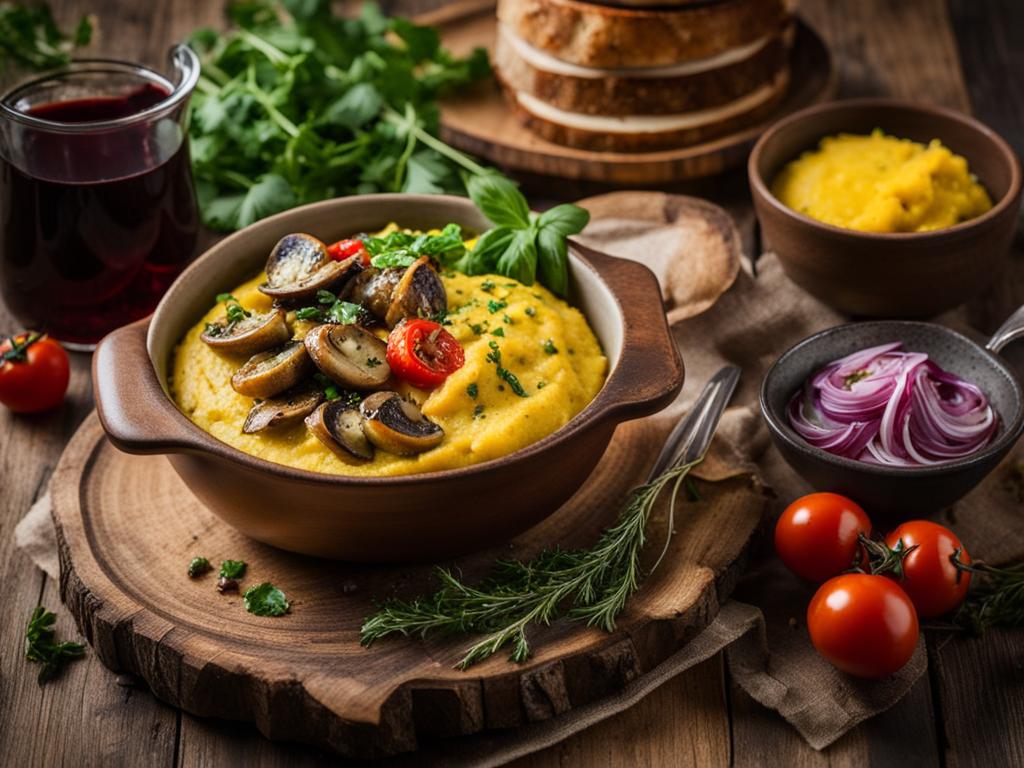
So, why wait? Grab your apron, get creative, and explore the endless possibilities of polenta in your own kitchen, creating delicious meals that will impress your family and friends.
Conclusion
In the world of comfort food, polenta shines as a versatile and delicious dish perfect for every occasion. With its humble origins in Italian cuisine, polenta brings simplicity and a burst of flavor to the table. Made from cornmeal and water, polenta offers endless possibilities to satisfy your cravings.
From being a creamy and comforting accompaniment to meats or transforming into crispy and flavorful fries, polenta never fails to impress. It can even be the foundation for mouthwatering lasagnas or cakes that will leave you craving for more. The versatility of polenta knows no bounds.
So why not dive into the world of polenta and uncover its deliciousness in your own kitchen? Experiment with flavors, get creative with presentations, and indulge in the comforting simplicity of this beloved dish. Let polenta be your companion in creating memorable meals that will leave everyone craving for another delicious bite.
Print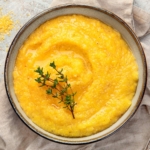
What Is Polenta? Uncover Its Delicious Versatility!
Description
Polenta is a classic Italian dish made from coarsely ground yellow cornmeal. It can be cooked to a creamy texture or sliced and grilled, fried, or baked. Versatile and comforting, polenta is a staple in Italian cuisine.
Ingredients
For the Polenta:
- Water or chicken stock
- Stone-ground dried yellow corn kernels
- Salt
- Butter
- Pepper
- (Optional) Grated Parmesan cheese
For Polenta Fries:
- 1 cup cooked polenta
- 1–2 tablespoons oil (such as olive or avocado oil)
- Salt and pepper to taste
- Air fryer or oven
- Optional: Dipping sauce of your choice
Instructions
For the Polenta:
- Step 1 – Bring water or chicken stock to a rapid boil in your chosen pot.
- Step 2 – Take your polenta and slowly whisk it into the boiling liquid, adding salt to taste.
- Step 3 – Reduce the heat to low and let the mixture simmer gently.
- Step 4 – Stir the polenta occasionally to prevent lumps from forming and to achieve a smooth and creamy texture.
- Step 5 – The cooking process usually takes around 40 minutes, but be sure to check the package instructions for specific cooking times.
- Step 6 – Towards the end of the cooking time, add butter, salt, and pepper according to your taste preferences.
- Step 7 – (Optional) For some extra flavor, you can also stir in grated Parmesan cheese.
For Polenta Fries:
- Step 1 – Allow the cooked polenta to cool and set. Slice it into uniform strips resembling large french fries.
- Step 2 – Lightly brush or spray the polenta slices with oil to coat them evenly.
- Step 3 – Sprinkle the polenta slices with salt and pepper to add flavor.
- Step 4 – Cook the polenta fries in an air fryer or oven according to the equipment’s instructions until crispy and golden brown.
- Step 5 – Serve the polenta fries hot or at room temperature with your favorite dipping sauce.
FAQ
What is polenta?
Polenta is a popular Northern Italian dish made from coarsely ground yellow corn. It is known for its simplicity and versatility, making it a favorite in both home kitchens and restaurants. Traditional polenta requires just a few ingredients like water or stock, butter, salt, and pepper. It can also be made more indulgent by adding parmesan cheese. Polenta is commonly served in various ways, such as fried with marinara sauce, as a creamy accompaniment to meat dishes, or as croutons on salads.
What is polenta made of?
Polenta is made from stone-ground dried yellow corn kernels that have a flaky texture. The corn used for polenta comes from a variety called flint corn, which has less starch compared to dent corn used for making grits. This difference in starch content gives polenta a slightly different texture and taste compared to grits. While some recipes may call for cornmeal as a substitute, it is ground more finely than polenta and lacks the characteristic texture. When shopping for polenta, it is best to look for packages specifically labeled as polenta. Instant, quick-cooking, or tubed polenta may be convenient, but they often lack flavor and have a mushy consistency.
How do you cook polenta?
Cooking polenta is not as complicated as it may seem. It involves a simple process that requires frequent stirring to prevent lumps and achieve a smooth and creamy texture. While a traditional copper polenta pot is ideal, any medium-sized saucepan will do the job. To cook basic polenta at home, bring water or chicken stock to a rapid boil, slowly whisk in the polenta and salt, then reduce heat and simmer while stirring occasionally. The cooking process takes about 40 minutes and requires adding butter, salt, and pepper towards the end for additional flavor. Some recipes may also call for grated parmesan cheese.
What is the history of polenta?
Polenta has a rich history that can be traced back to ancient Roman times when it was known as puls, a porridge made from various grains. In medieval times, polenta was made from chestnut flour, which was abundant in northern Italy. It wasn’t until the introduction of corn from the Americas in the 16th century that cornmeal became the primary ingredient in polenta. Over time, polenta evolved into the traditional dish we know today. It has been a staple in Italian cuisine, especially in the northern regions, and has gained popularity worldwide for its versatility and delicious flavor.
How can polenta be used as a base for dishes?
Polenta serves as an excellent base for a variety of dishes. For example, polenta can be used as a substitute for pasta in polenta lasagna, where layers of polenta are used instead of traditional noodles. It can also be transformed into polenta cakes, which are a tasty gluten-free alternative to regular cakes. The cooked polenta is spread out in a dish, cooled, and set to firm up before cutting it into squares or other shapes. These polenta squares can be fried until crispy or grilled and served as a side dish or topped with various ingredients like roasted vegetables or tomato sauce.
How do you make polenta fries?
Polenta fries are a delicious and crunchy treat that can be enjoyed as a side dish, snack, or even a starter. The process to make these fries involves allowing the cooked polenta to cool and set before cutting it into uniform slices resembling large french fries. The polenta slices are then lightly brushed or sprayed with oil, sprinkled with salt and pepper, and cooked in an air fryer or oven until crispy and golden brown. Polenta fries can be served hot or at room temperature, making them a versatile and tasty option.
What is the significance of polenta in Italian “cucina povera”?
Polenta has deep roots in Italian “cucina povera,” which translates to “peasant cooking” or “poor kitchen.” It was a simple and affordable dish made from cornmeal and water, sustaining many families for centuries. Polenta was often the main source of nutrition, especially for the poor. Over time, as economic conditions improved, people began to accompany their polenta with other foods. Today, polenta is celebrated as both a tasty and nutritious dish that can be enjoyed in various ways.
What are some delicious polenta recipes?
Polenta’s versatility extends to creating a wide range of recipes that are bursting with flavor. From breakfast to dessert, there is a polenta recipe for every meal. Some popular options include polenta porridge with sweet toppings like berries and honey for breakfast, creamy polenta with sautéed mushrooms for a comforting lunch, polenta lasagna for a satisfying dinner, and polenta cake with citrus glaze for a delightful dessert. The possibilities are endless, allowing you to explore and get creative with this versatile ingredient.
